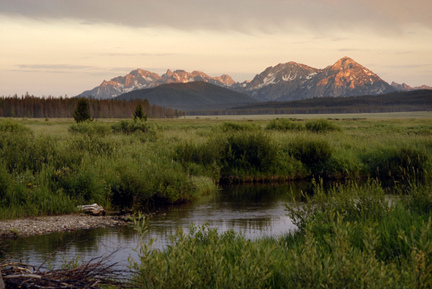Keeping Wilderness Wild
When the first Europeans settled in what is now the United States, they found a continent of extensive wildlands. In less than 500 years, the undeveloped nature of these wildlands has been reduced significantly. As they became increasingly scarce and a fledgling conservation movement lost natural treasures like Yosemite’s Hetch Hetchy Valley to development, Americans began to appreciate their value.

View of the Sawtooth Range in Idaho. U.S. Forest Service photo.
With passage of the Wilderness Act of 1964, a new course in history was chartered — to preserve some of the country’s last remaining wild places and protect their natural processes and values from development.
The interagency Arthur Carhart National Wilderness Training Center, located in Missoula, Mont., was created in 1993 to empower federal agency employees and the public to preserve their wilderness heritage through training, information and education. It has become a critical resource for land managers from the Forest Service, Bureau of Land Management, Fish and Wildlife Service and National Park Service as they manage more than 109 million acres of designated wilderness from Alaska to Puerto Rico.
The center’s staff of seven works with experts within and outside the agencies to develop comprehensive interagency solutions to critical stewardship issues. Materials are distributed electronically to each of the 792 units comprising America’s National Wilderness Preservation System, and training is offered where it is most needed. Most recently, in collaboration with the Aldo Leopold Wilderness Research Institute and the Wilderness Institute at the University of Montana, the center conducted a webinar called The Foundation and Qualities of Wilderness Character.
This interactive, collaborative approach to training and coaching ensures that the Carhart Center continues providing training and information that employees need, when they need it, so that they can keep wilderness wild.

I am Dr. Robert Kamansky and I am a Stakeholder at my local watershed consortium, SAWPA -Santa Ana River Watershed Consortium. I have a certificate from a University in Watershed Management. I usually do not comment on these matters. I recently returned from a major Water& Climate Change meeting at the Orange County Municipal Water District. I commented on the scientific fact that future Climate Change will effect the water dynamics of the Hetch Hetchy Valley; and that as many recent articles in the LA Times admits that the San Francisco Bay Area needs to do a lot more in matters of water conservation and recycling as they promised when they signed off on the Hetch Hetchy agreement many decades ago. Dr. Kamansky
I, myself, find there is not enough being done to prevent the end of the wilderness & too much being allowed to KILL off what is our last American heritages, the wolf, the coyote, and the most beautiful and last link to our Amrican Historical Past, The Mustang/Wild Horses. All of these 3 have had Death Sentences placed on them in various parts of this country, least we are forgetting that their ancestors were her long before white man stepped foot on this American Continent. All are not bothing anyone except the greedy ranchers who think all pasture land belongs to them and have yet to learn that if they do not want their herds culled by wolves or coyotes who are just killing only what they need to survive. And for the most part we, in this “free country should all be allowed to survive, man & beast alike”… Actually the wolf as well as the coyote only kill the infirmed, the too old, and the weak already abonadoned by their own herds & NOT what propaganda is trying to make the cityslickers & business suits believe. ENOUGH IS ENOUGH FOLKS or there won’t be any nature left for our children’s children and our future generations to come. Stop government and corporations from being greedy and being KILLERS; next they will put bounty on old human heads saying elderly can only live to a certain age…
A long time resident and outdoorsman, I think Wilderness designations are just fine. The Flat Tops region near Yampa, CO a great example: Trappers Lake and surrounding peaks. I’ve seen wild horses in the McElmo Creek near Cortez, in Theodore Roosevelt NP and in Wyoming’s Seedskadee NWR near Green River. Wild horses are in our national parks, refuges and BLM tracts. Ranchers are not greedy-they lease grazing rights on public lands/their own lands.Ranchers have a stake in clean water, conservation. Energy,and timber interests pay extraction fees and taxes for providing jobs in rural areas, hence we need to plan, organize and set apart balanced land use zones/perimeters for all. Culling wildlife is required to prevent animal hunger, disease and predation. Wilderness areas keep out vehicles, beer cans and plastic diapers left in fire rings.Dams are needed to conserve water in the nation’s interior and provide fishing, birding opportunities. The wolves and coyotes wont get killed in wilderness/parks designations, but are fair game in cattle property. I’m uncomfortable with killing bears and bison, that’s me talkin’.